Detailed Report on Security Challenges in Cloud and Edge Computing
VerifiedAdded on 2022/01/05
|9
|1882
|24
Report
AI Summary
This report delves into the security challenges present in both edge and cloud computing environments. It highlights the vulnerabilities associated with multi-tenancy, where shared environments can lead to data isolation and interference, as well as susceptibility to DDoS and Man-in-the-middle attacks. The report further examines the risks of multi-site and multi-technology deployments, where excessive traffic and interconnected technologies can compromise security. The complexity of roles and responsibilities within a hierarchical structure, the challenges in data segregation, and the potential threats to data recovery processes are also discussed. Furthermore, the report emphasizes the importance of addressing privacy issues, particularly concerning the protection of personal and organizational data. The conclusion underscores the crucial need for robust security measures to mitigate these risks in both edge and cloud computing paradigms.
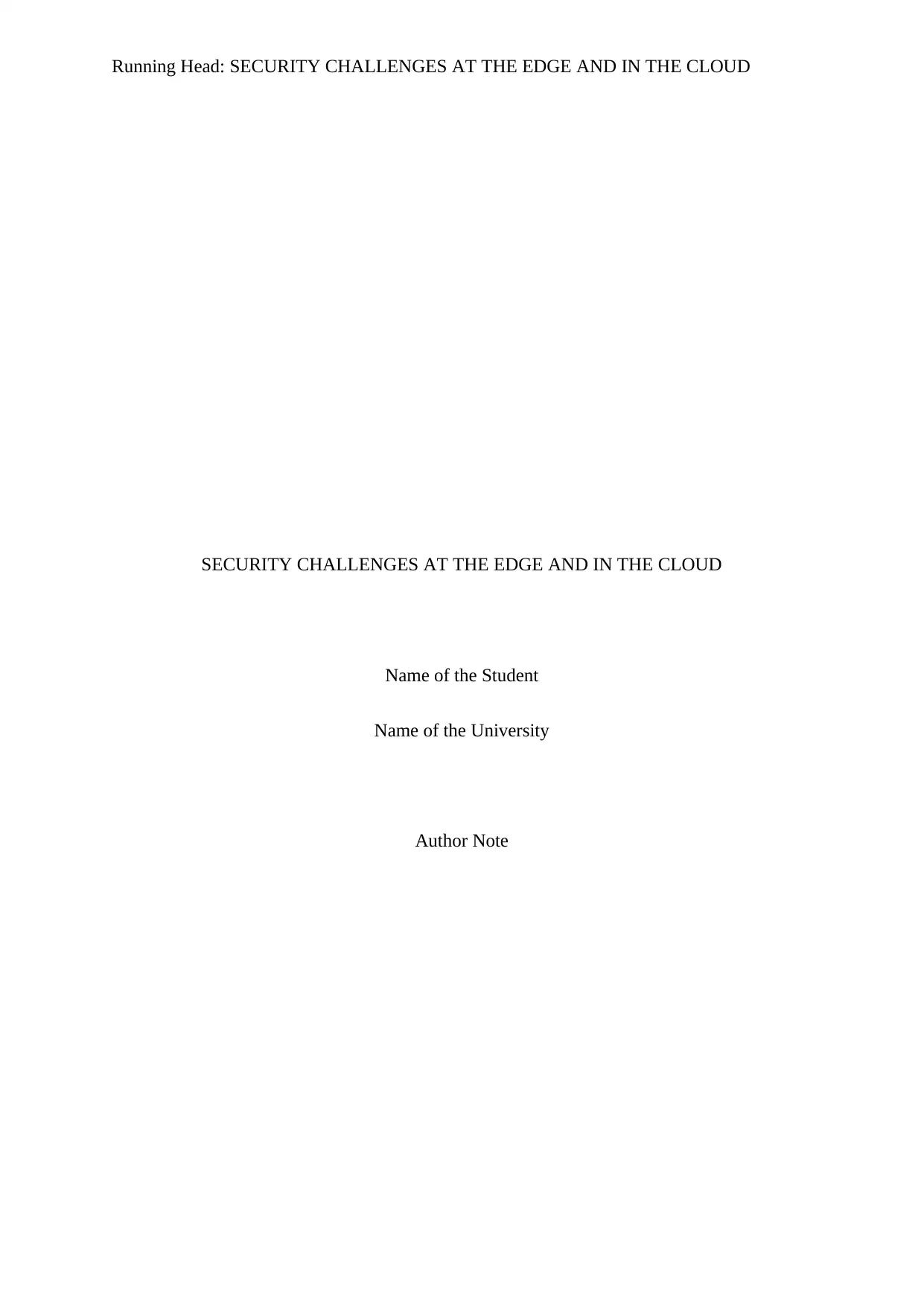
Running Head: SECURITY CHALLENGES AT THE EDGE AND IN THE CLOUD
SECURITY CHALLENGES AT THE EDGE AND IN THE CLOUD
Name of the Student
Name of the University
Author Note
SECURITY CHALLENGES AT THE EDGE AND IN THE CLOUD
Name of the Student
Name of the University
Author Note
Paraphrase This Document
Need a fresh take? Get an instant paraphrase of this document with our AI Paraphraser
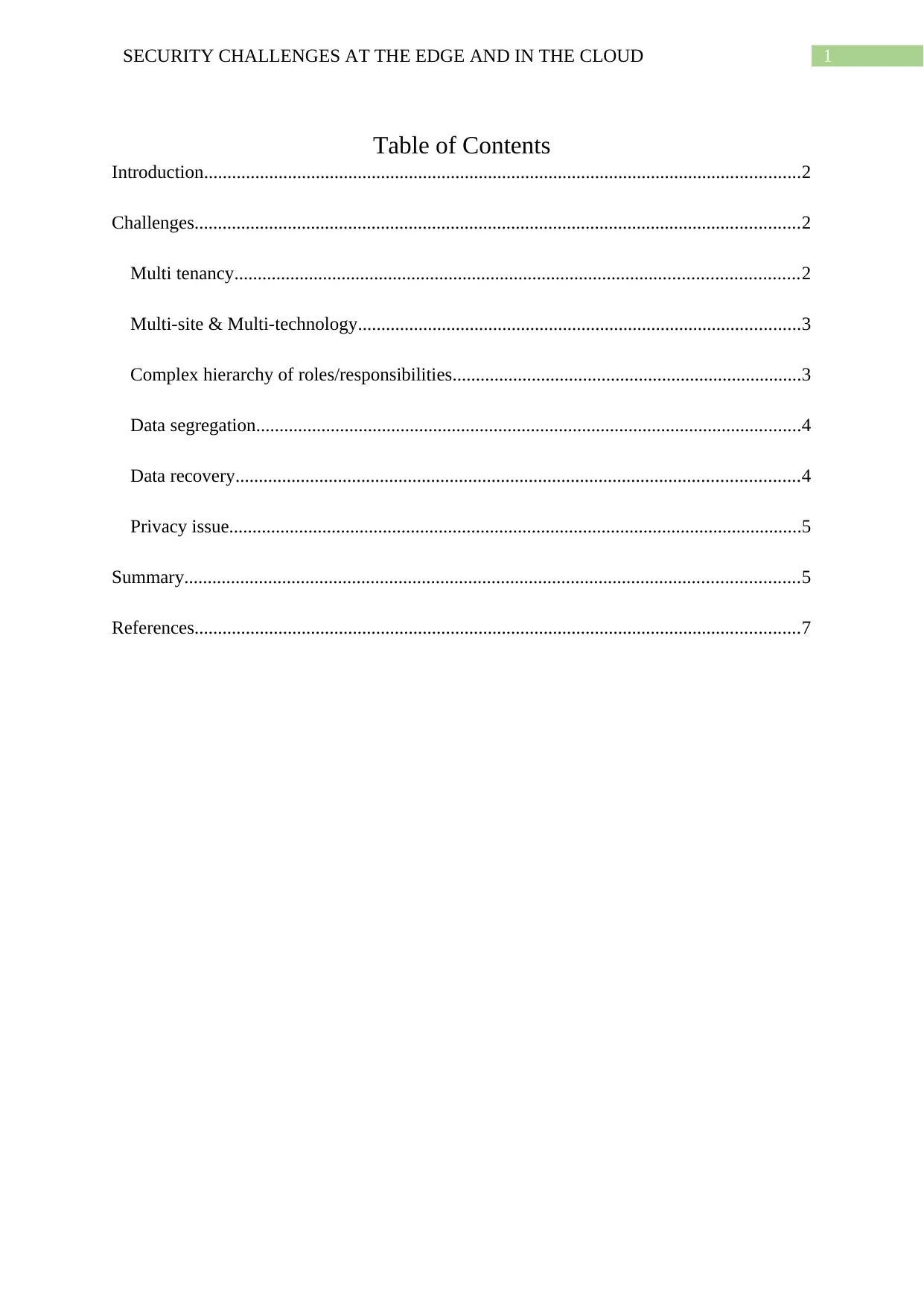
1SECURITY CHALLENGES AT THE EDGE AND IN THE CLOUD
Table of Contents
Introduction................................................................................................................................2
Challenges..................................................................................................................................2
Multi tenancy.........................................................................................................................2
Multi-site & Multi-technology...............................................................................................3
Complex hierarchy of roles/responsibilities...........................................................................3
Data segregation.....................................................................................................................4
Data recovery.........................................................................................................................4
Privacy issue...........................................................................................................................5
Summary....................................................................................................................................5
References..................................................................................................................................7
Table of Contents
Introduction................................................................................................................................2
Challenges..................................................................................................................................2
Multi tenancy.........................................................................................................................2
Multi-site & Multi-technology...............................................................................................3
Complex hierarchy of roles/responsibilities...........................................................................3
Data segregation.....................................................................................................................4
Data recovery.........................................................................................................................4
Privacy issue...........................................................................................................................5
Summary....................................................................................................................................5
References..................................................................................................................................7
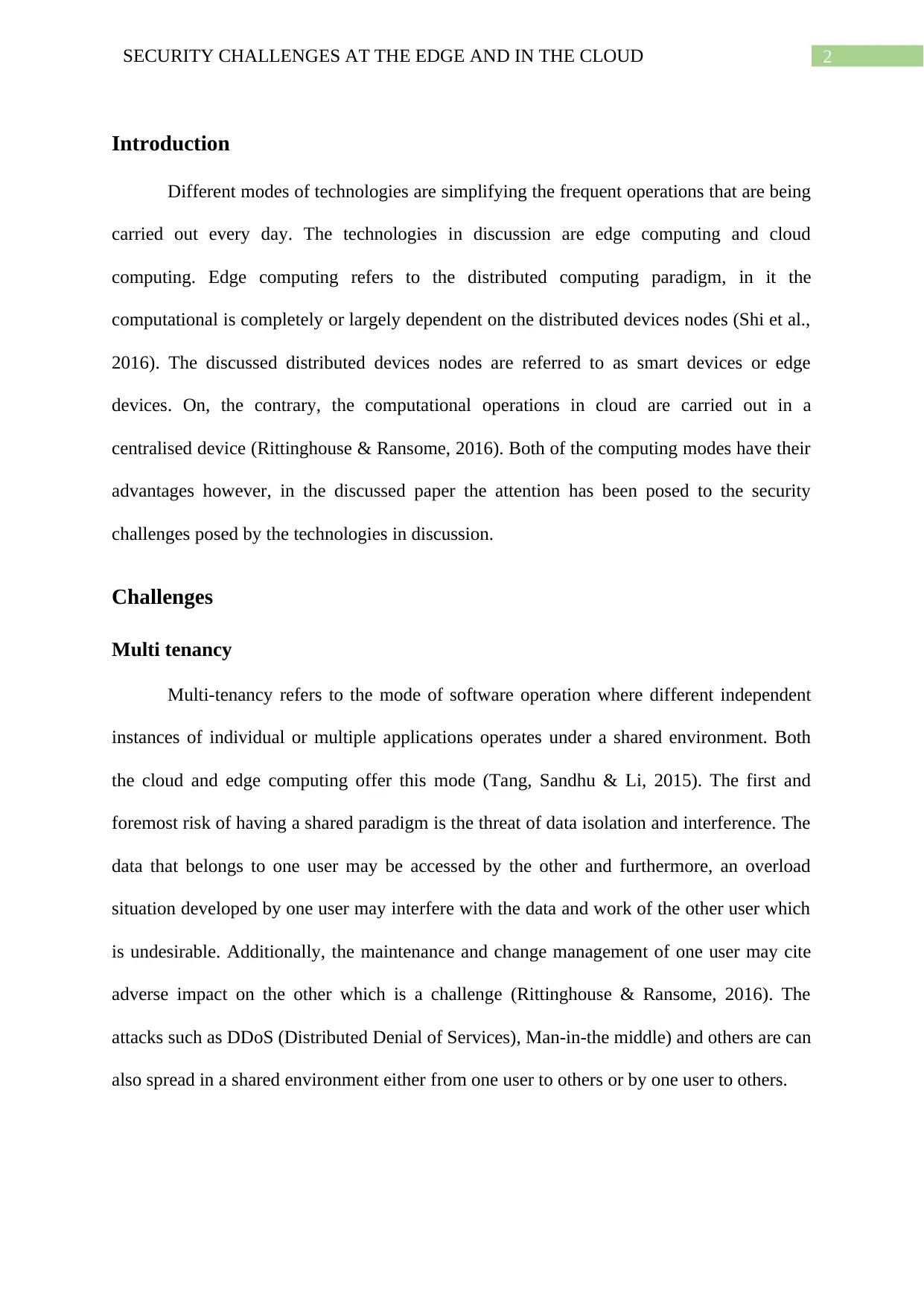
2SECURITY CHALLENGES AT THE EDGE AND IN THE CLOUD
Introduction
Different modes of technologies are simplifying the frequent operations that are being
carried out every day. The technologies in discussion are edge computing and cloud
computing. Edge computing refers to the distributed computing paradigm, in it the
computational is completely or largely dependent on the distributed devices nodes (Shi et al.,
2016). The discussed distributed devices nodes are referred to as smart devices or edge
devices. On, the contrary, the computational operations in cloud are carried out in a
centralised device (Rittinghouse & Ransome, 2016). Both of the computing modes have their
advantages however, in the discussed paper the attention has been posed to the security
challenges posed by the technologies in discussion.
Challenges
Multi tenancy
Multi-tenancy refers to the mode of software operation where different independent
instances of individual or multiple applications operates under a shared environment. Both
the cloud and edge computing offer this mode (Tang, Sandhu & Li, 2015). The first and
foremost risk of having a shared paradigm is the threat of data isolation and interference. The
data that belongs to one user may be accessed by the other and furthermore, an overload
situation developed by one user may interfere with the data and work of the other user which
is undesirable. Additionally, the maintenance and change management of one user may cite
adverse impact on the other which is a challenge (Rittinghouse & Ransome, 2016). The
attacks such as DDoS (Distributed Denial of Services), Man-in-the middle) and others are can
also spread in a shared environment either from one user to others or by one user to others.
Introduction
Different modes of technologies are simplifying the frequent operations that are being
carried out every day. The technologies in discussion are edge computing and cloud
computing. Edge computing refers to the distributed computing paradigm, in it the
computational is completely or largely dependent on the distributed devices nodes (Shi et al.,
2016). The discussed distributed devices nodes are referred to as smart devices or edge
devices. On, the contrary, the computational operations in cloud are carried out in a
centralised device (Rittinghouse & Ransome, 2016). Both of the computing modes have their
advantages however, in the discussed paper the attention has been posed to the security
challenges posed by the technologies in discussion.
Challenges
Multi tenancy
Multi-tenancy refers to the mode of software operation where different independent
instances of individual or multiple applications operates under a shared environment. Both
the cloud and edge computing offer this mode (Tang, Sandhu & Li, 2015). The first and
foremost risk of having a shared paradigm is the threat of data isolation and interference. The
data that belongs to one user may be accessed by the other and furthermore, an overload
situation developed by one user may interfere with the data and work of the other user which
is undesirable. Additionally, the maintenance and change management of one user may cite
adverse impact on the other which is a challenge (Rittinghouse & Ransome, 2016). The
attacks such as DDoS (Distributed Denial of Services), Man-in-the middle) and others are can
also spread in a shared environment either from one user to others or by one user to others.
⊘ This is a preview!⊘
Do you want full access?
Subscribe today to unlock all pages.

Trusted by 1+ million students worldwide
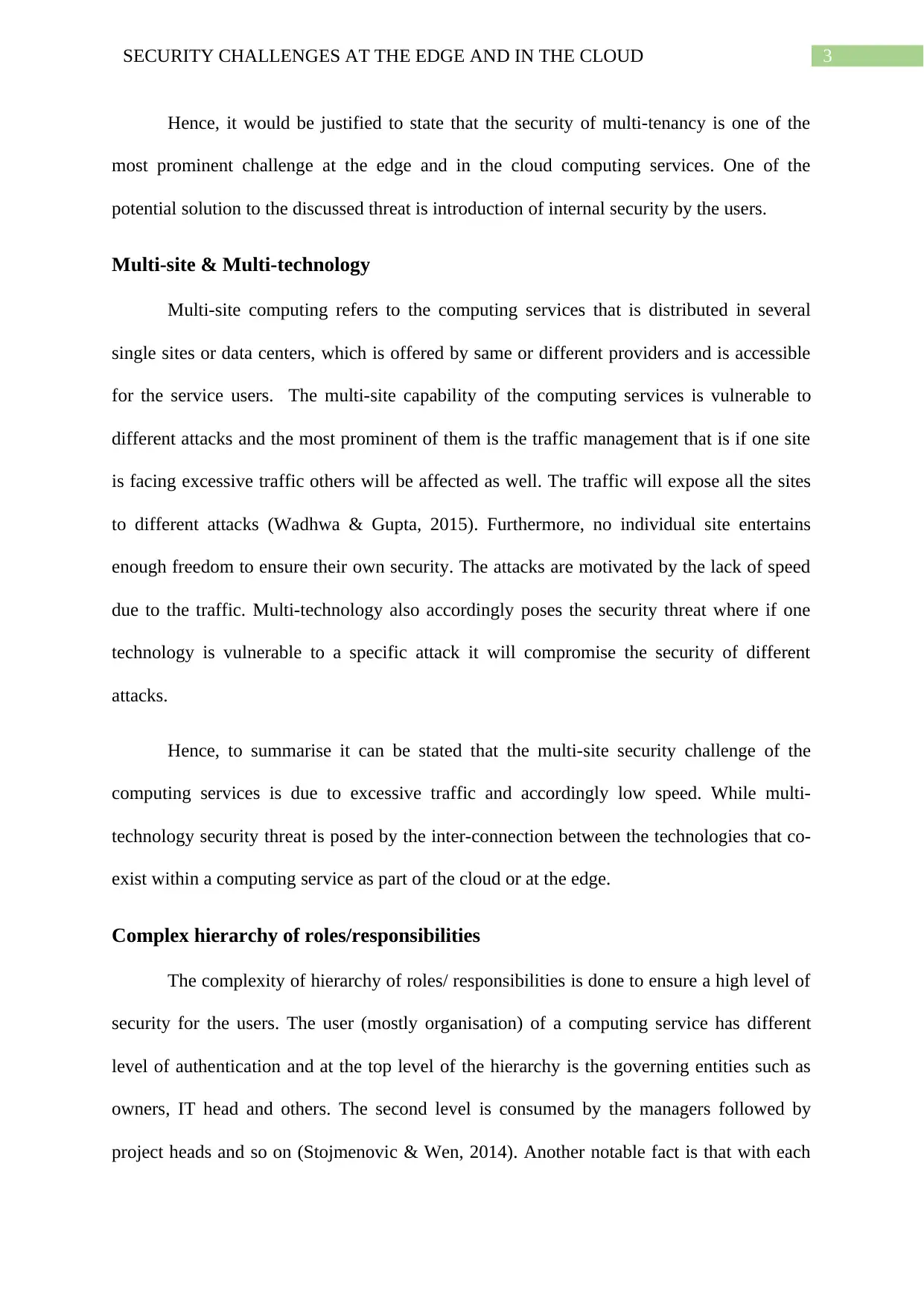
3SECURITY CHALLENGES AT THE EDGE AND IN THE CLOUD
Hence, it would be justified to state that the security of multi-tenancy is one of the
most prominent challenge at the edge and in the cloud computing services. One of the
potential solution to the discussed threat is introduction of internal security by the users.
Multi-site & Multi-technology
Multi-site computing refers to the computing services that is distributed in several
single sites or data centers, which is offered by same or different providers and is accessible
for the service users. The multi-site capability of the computing services is vulnerable to
different attacks and the most prominent of them is the traffic management that is if one site
is facing excessive traffic others will be affected as well. The traffic will expose all the sites
to different attacks (Wadhwa & Gupta, 2015). Furthermore, no individual site entertains
enough freedom to ensure their own security. The attacks are motivated by the lack of speed
due to the traffic. Multi-technology also accordingly poses the security threat where if one
technology is vulnerable to a specific attack it will compromise the security of different
attacks.
Hence, to summarise it can be stated that the multi-site security challenge of the
computing services is due to excessive traffic and accordingly low speed. While multi-
technology security threat is posed by the inter-connection between the technologies that co-
exist within a computing service as part of the cloud or at the edge.
Complex hierarchy of roles/responsibilities
The complexity of hierarchy of roles/ responsibilities is done to ensure a high level of
security for the users. The user (mostly organisation) of a computing service has different
level of authentication and at the top level of the hierarchy is the governing entities such as
owners, IT head and others. The second level is consumed by the managers followed by
project heads and so on (Stojmenovic & Wen, 2014). Another notable fact is that with each
Hence, it would be justified to state that the security of multi-tenancy is one of the
most prominent challenge at the edge and in the cloud computing services. One of the
potential solution to the discussed threat is introduction of internal security by the users.
Multi-site & Multi-technology
Multi-site computing refers to the computing services that is distributed in several
single sites or data centers, which is offered by same or different providers and is accessible
for the service users. The multi-site capability of the computing services is vulnerable to
different attacks and the most prominent of them is the traffic management that is if one site
is facing excessive traffic others will be affected as well. The traffic will expose all the sites
to different attacks (Wadhwa & Gupta, 2015). Furthermore, no individual site entertains
enough freedom to ensure their own security. The attacks are motivated by the lack of speed
due to the traffic. Multi-technology also accordingly poses the security threat where if one
technology is vulnerable to a specific attack it will compromise the security of different
attacks.
Hence, to summarise it can be stated that the multi-site security challenge of the
computing services is due to excessive traffic and accordingly low speed. While multi-
technology security threat is posed by the inter-connection between the technologies that co-
exist within a computing service as part of the cloud or at the edge.
Complex hierarchy of roles/responsibilities
The complexity of hierarchy of roles/ responsibilities is done to ensure a high level of
security for the users. The user (mostly organisation) of a computing service has different
level of authentication and at the top level of the hierarchy is the governing entities such as
owners, IT head and others. The second level is consumed by the managers followed by
project heads and so on (Stojmenovic & Wen, 2014). Another notable fact is that with each
Paraphrase This Document
Need a fresh take? Get an instant paraphrase of this document with our AI Paraphraser
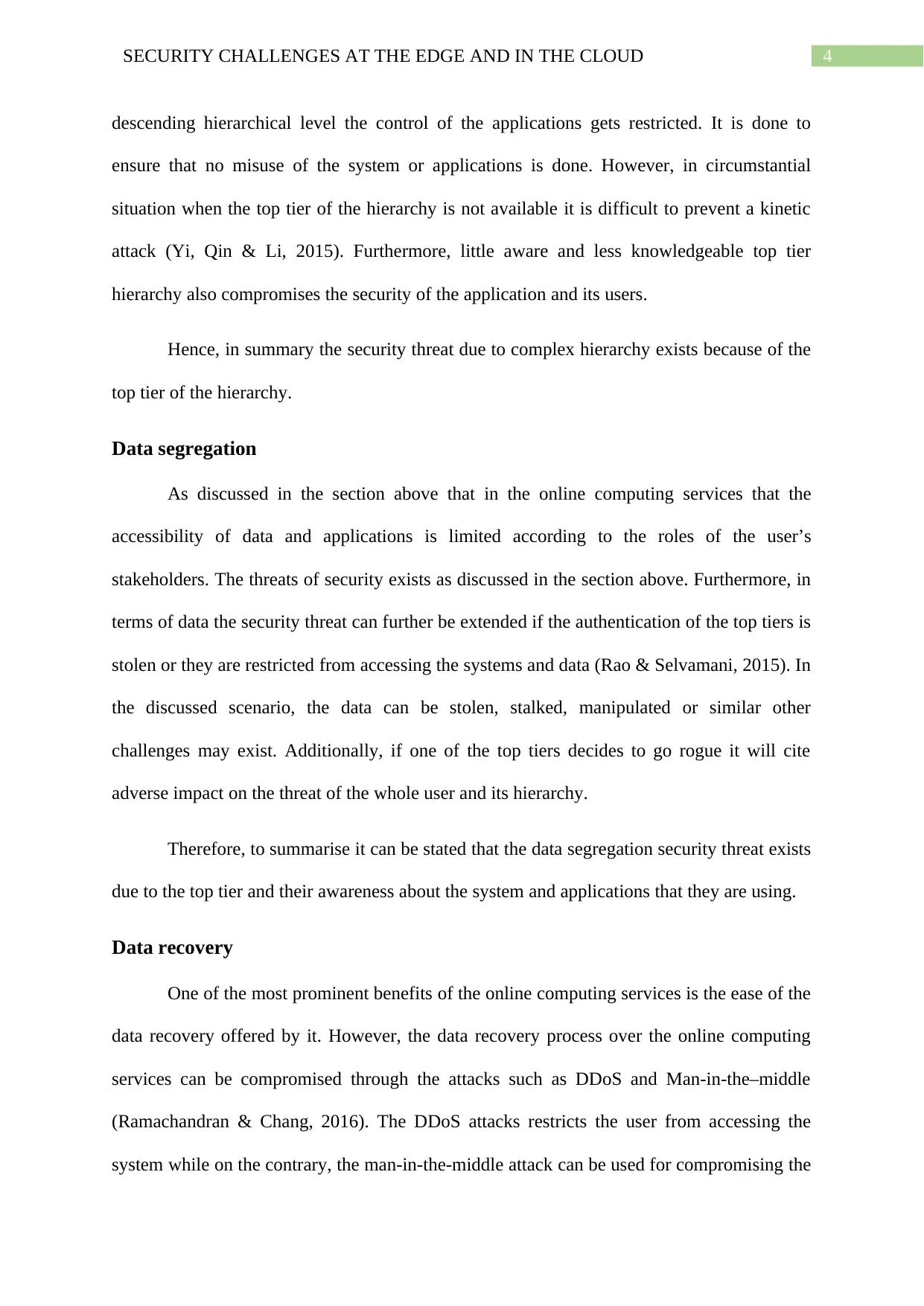
4SECURITY CHALLENGES AT THE EDGE AND IN THE CLOUD
descending hierarchical level the control of the applications gets restricted. It is done to
ensure that no misuse of the system or applications is done. However, in circumstantial
situation when the top tier of the hierarchy is not available it is difficult to prevent a kinetic
attack (Yi, Qin & Li, 2015). Furthermore, little aware and less knowledgeable top tier
hierarchy also compromises the security of the application and its users.
Hence, in summary the security threat due to complex hierarchy exists because of the
top tier of the hierarchy.
Data segregation
As discussed in the section above that in the online computing services that the
accessibility of data and applications is limited according to the roles of the user’s
stakeholders. The threats of security exists as discussed in the section above. Furthermore, in
terms of data the security threat can further be extended if the authentication of the top tiers is
stolen or they are restricted from accessing the systems and data (Rao & Selvamani, 2015). In
the discussed scenario, the data can be stolen, stalked, manipulated or similar other
challenges may exist. Additionally, if one of the top tiers decides to go rogue it will cite
adverse impact on the threat of the whole user and its hierarchy.
Therefore, to summarise it can be stated that the data segregation security threat exists
due to the top tier and their awareness about the system and applications that they are using.
Data recovery
One of the most prominent benefits of the online computing services is the ease of the
data recovery offered by it. However, the data recovery process over the online computing
services can be compromised through the attacks such as DDoS and Man-in-the–middle
(Ramachandran & Chang, 2016). The DDoS attacks restricts the user from accessing the
system while on the contrary, the man-in-the-middle attack can be used for compromising the
descending hierarchical level the control of the applications gets restricted. It is done to
ensure that no misuse of the system or applications is done. However, in circumstantial
situation when the top tier of the hierarchy is not available it is difficult to prevent a kinetic
attack (Yi, Qin & Li, 2015). Furthermore, little aware and less knowledgeable top tier
hierarchy also compromises the security of the application and its users.
Hence, in summary the security threat due to complex hierarchy exists because of the
top tier of the hierarchy.
Data segregation
As discussed in the section above that in the online computing services that the
accessibility of data and applications is limited according to the roles of the user’s
stakeholders. The threats of security exists as discussed in the section above. Furthermore, in
terms of data the security threat can further be extended if the authentication of the top tiers is
stolen or they are restricted from accessing the systems and data (Rao & Selvamani, 2015). In
the discussed scenario, the data can be stolen, stalked, manipulated or similar other
challenges may exist. Additionally, if one of the top tiers decides to go rogue it will cite
adverse impact on the threat of the whole user and its hierarchy.
Therefore, to summarise it can be stated that the data segregation security threat exists
due to the top tier and their awareness about the system and applications that they are using.
Data recovery
One of the most prominent benefits of the online computing services is the ease of the
data recovery offered by it. However, the data recovery process over the online computing
services can be compromised through the attacks such as DDoS and Man-in-the–middle
(Ramachandran & Chang, 2016). The DDoS attacks restricts the user from accessing the
system while on the contrary, the man-in-the-middle attack can be used for compromising the
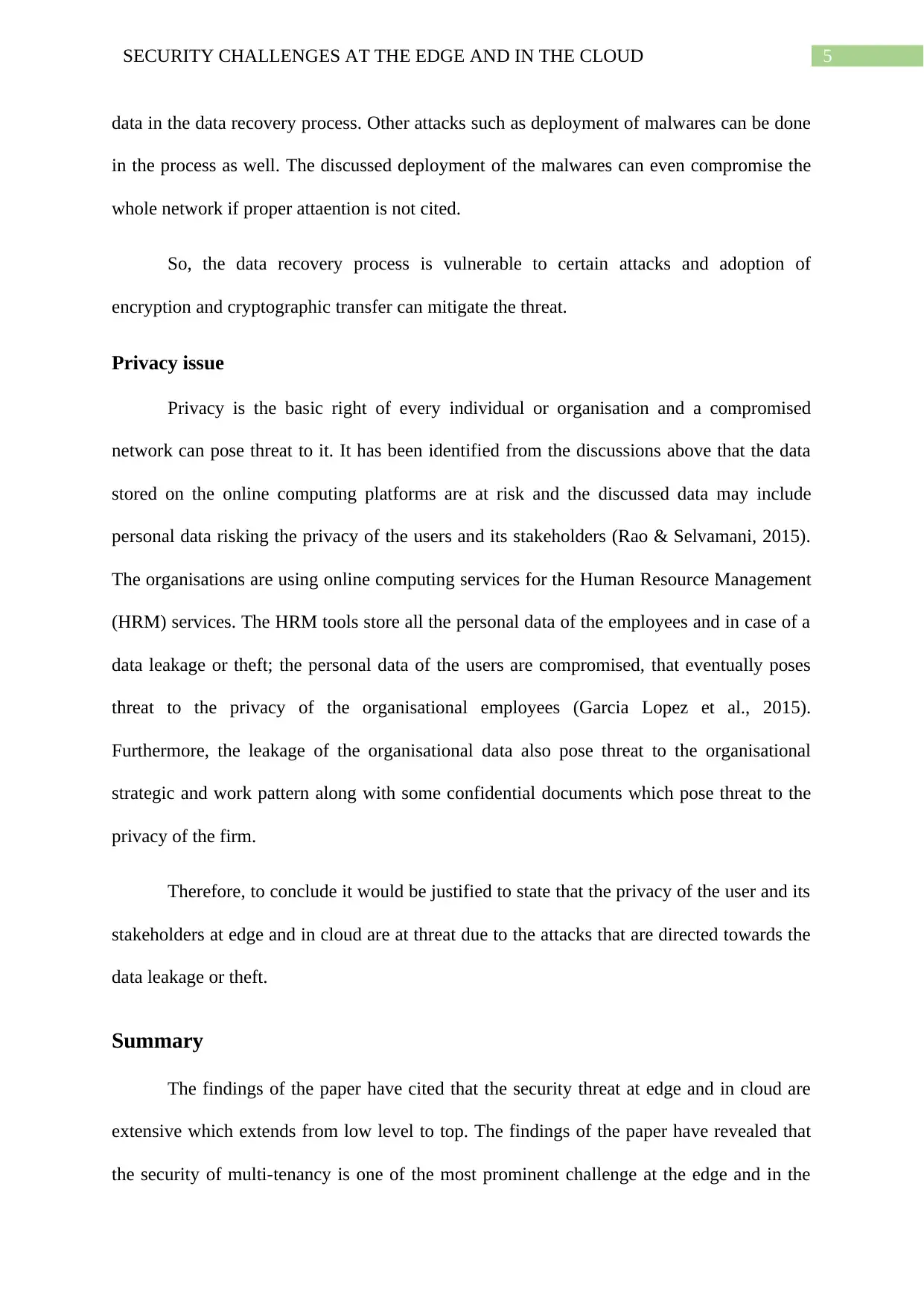
5SECURITY CHALLENGES AT THE EDGE AND IN THE CLOUD
data in the data recovery process. Other attacks such as deployment of malwares can be done
in the process as well. The discussed deployment of the malwares can even compromise the
whole network if proper attaention is not cited.
So, the data recovery process is vulnerable to certain attacks and adoption of
encryption and cryptographic transfer can mitigate the threat.
Privacy issue
Privacy is the basic right of every individual or organisation and a compromised
network can pose threat to it. It has been identified from the discussions above that the data
stored on the online computing platforms are at risk and the discussed data may include
personal data risking the privacy of the users and its stakeholders (Rao & Selvamani, 2015).
The organisations are using online computing services for the Human Resource Management
(HRM) services. The HRM tools store all the personal data of the employees and in case of a
data leakage or theft; the personal data of the users are compromised, that eventually poses
threat to the privacy of the organisational employees (Garcia Lopez et al., 2015).
Furthermore, the leakage of the organisational data also pose threat to the organisational
strategic and work pattern along with some confidential documents which pose threat to the
privacy of the firm.
Therefore, to conclude it would be justified to state that the privacy of the user and its
stakeholders at edge and in cloud are at threat due to the attacks that are directed towards the
data leakage or theft.
Summary
The findings of the paper have cited that the security threat at edge and in cloud are
extensive which extends from low level to top. The findings of the paper have revealed that
the security of multi-tenancy is one of the most prominent challenge at the edge and in the
data in the data recovery process. Other attacks such as deployment of malwares can be done
in the process as well. The discussed deployment of the malwares can even compromise the
whole network if proper attaention is not cited.
So, the data recovery process is vulnerable to certain attacks and adoption of
encryption and cryptographic transfer can mitigate the threat.
Privacy issue
Privacy is the basic right of every individual or organisation and a compromised
network can pose threat to it. It has been identified from the discussions above that the data
stored on the online computing platforms are at risk and the discussed data may include
personal data risking the privacy of the users and its stakeholders (Rao & Selvamani, 2015).
The organisations are using online computing services for the Human Resource Management
(HRM) services. The HRM tools store all the personal data of the employees and in case of a
data leakage or theft; the personal data of the users are compromised, that eventually poses
threat to the privacy of the organisational employees (Garcia Lopez et al., 2015).
Furthermore, the leakage of the organisational data also pose threat to the organisational
strategic and work pattern along with some confidential documents which pose threat to the
privacy of the firm.
Therefore, to conclude it would be justified to state that the privacy of the user and its
stakeholders at edge and in cloud are at threat due to the attacks that are directed towards the
data leakage or theft.
Summary
The findings of the paper have cited that the security threat at edge and in cloud are
extensive which extends from low level to top. The findings of the paper have revealed that
the security of multi-tenancy is one of the most prominent challenge at the edge and in the
⊘ This is a preview!⊘
Do you want full access?
Subscribe today to unlock all pages.

Trusted by 1+ million students worldwide
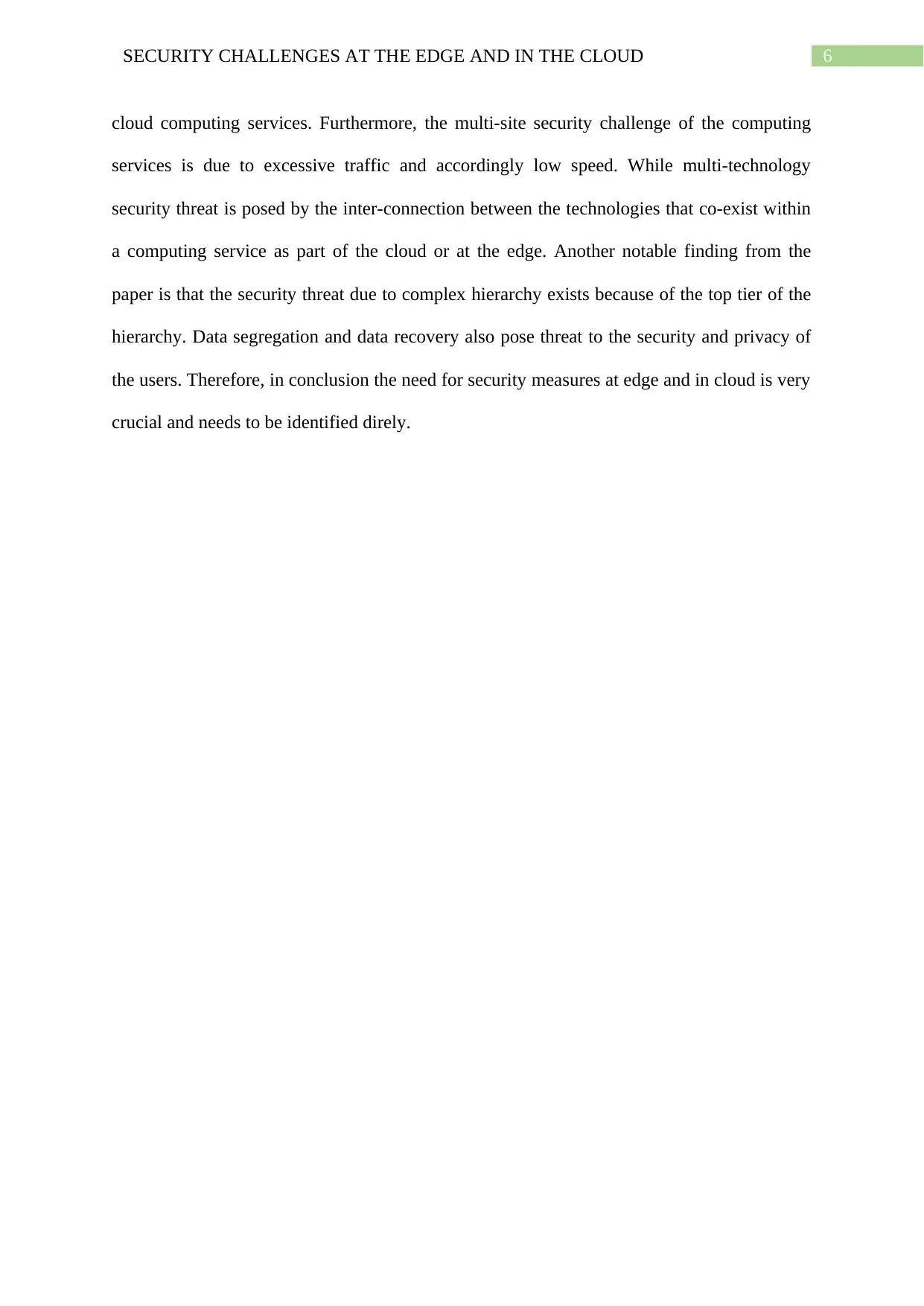
6SECURITY CHALLENGES AT THE EDGE AND IN THE CLOUD
cloud computing services. Furthermore, the multi-site security challenge of the computing
services is due to excessive traffic and accordingly low speed. While multi-technology
security threat is posed by the inter-connection between the technologies that co-exist within
a computing service as part of the cloud or at the edge. Another notable finding from the
paper is that the security threat due to complex hierarchy exists because of the top tier of the
hierarchy. Data segregation and data recovery also pose threat to the security and privacy of
the users. Therefore, in conclusion the need for security measures at edge and in cloud is very
crucial and needs to be identified direly.
cloud computing services. Furthermore, the multi-site security challenge of the computing
services is due to excessive traffic and accordingly low speed. While multi-technology
security threat is posed by the inter-connection between the technologies that co-exist within
a computing service as part of the cloud or at the edge. Another notable finding from the
paper is that the security threat due to complex hierarchy exists because of the top tier of the
hierarchy. Data segregation and data recovery also pose threat to the security and privacy of
the users. Therefore, in conclusion the need for security measures at edge and in cloud is very
crucial and needs to be identified direly.
Paraphrase This Document
Need a fresh take? Get an instant paraphrase of this document with our AI Paraphraser
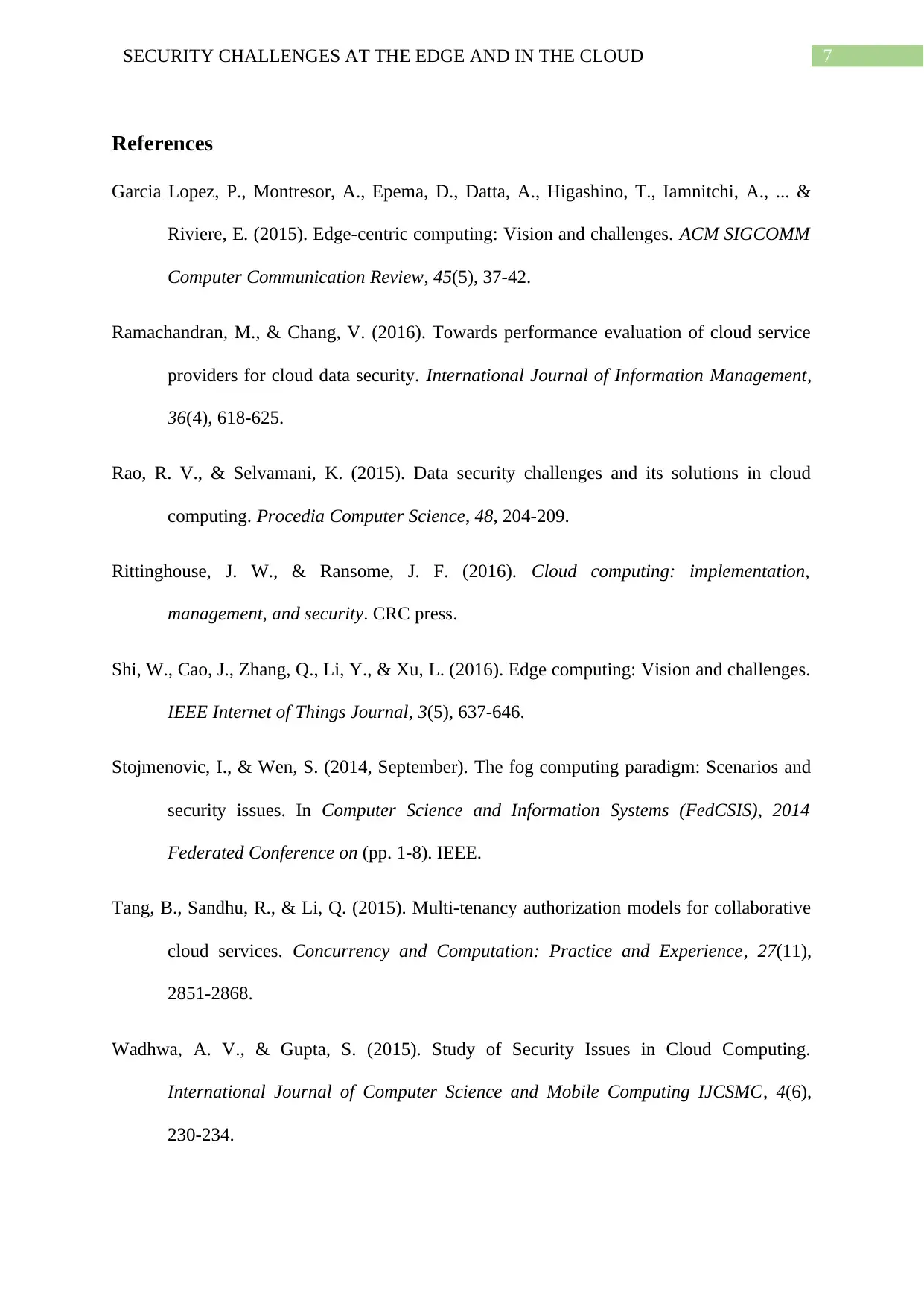
7SECURITY CHALLENGES AT THE EDGE AND IN THE CLOUD
References
Garcia Lopez, P., Montresor, A., Epema, D., Datta, A., Higashino, T., Iamnitchi, A., ... &
Riviere, E. (2015). Edge-centric computing: Vision and challenges. ACM SIGCOMM
Computer Communication Review, 45(5), 37-42.
Ramachandran, M., & Chang, V. (2016). Towards performance evaluation of cloud service
providers for cloud data security. International Journal of Information Management,
36(4), 618-625.
Rao, R. V., & Selvamani, K. (2015). Data security challenges and its solutions in cloud
computing. Procedia Computer Science, 48, 204-209.
Rittinghouse, J. W., & Ransome, J. F. (2016). Cloud computing: implementation,
management, and security. CRC press.
Shi, W., Cao, J., Zhang, Q., Li, Y., & Xu, L. (2016). Edge computing: Vision and challenges.
IEEE Internet of Things Journal, 3(5), 637-646.
Stojmenovic, I., & Wen, S. (2014, September). The fog computing paradigm: Scenarios and
security issues. In Computer Science and Information Systems (FedCSIS), 2014
Federated Conference on (pp. 1-8). IEEE.
Tang, B., Sandhu, R., & Li, Q. (2015). Multi‐tenancy authorization models for collaborative
cloud services. Concurrency and Computation: Practice and Experience, 27(11),
2851-2868.
Wadhwa, A. V., & Gupta, S. (2015). Study of Security Issues in Cloud Computing.
International Journal of Computer Science and Mobile Computing IJCSMC, 4(6),
230-234.
References
Garcia Lopez, P., Montresor, A., Epema, D., Datta, A., Higashino, T., Iamnitchi, A., ... &
Riviere, E. (2015). Edge-centric computing: Vision and challenges. ACM SIGCOMM
Computer Communication Review, 45(5), 37-42.
Ramachandran, M., & Chang, V. (2016). Towards performance evaluation of cloud service
providers for cloud data security. International Journal of Information Management,
36(4), 618-625.
Rao, R. V., & Selvamani, K. (2015). Data security challenges and its solutions in cloud
computing. Procedia Computer Science, 48, 204-209.
Rittinghouse, J. W., & Ransome, J. F. (2016). Cloud computing: implementation,
management, and security. CRC press.
Shi, W., Cao, J., Zhang, Q., Li, Y., & Xu, L. (2016). Edge computing: Vision and challenges.
IEEE Internet of Things Journal, 3(5), 637-646.
Stojmenovic, I., & Wen, S. (2014, September). The fog computing paradigm: Scenarios and
security issues. In Computer Science and Information Systems (FedCSIS), 2014
Federated Conference on (pp. 1-8). IEEE.
Tang, B., Sandhu, R., & Li, Q. (2015). Multi‐tenancy authorization models for collaborative
cloud services. Concurrency and Computation: Practice and Experience, 27(11),
2851-2868.
Wadhwa, A. V., & Gupta, S. (2015). Study of Security Issues in Cloud Computing.
International Journal of Computer Science and Mobile Computing IJCSMC, 4(6),
230-234.
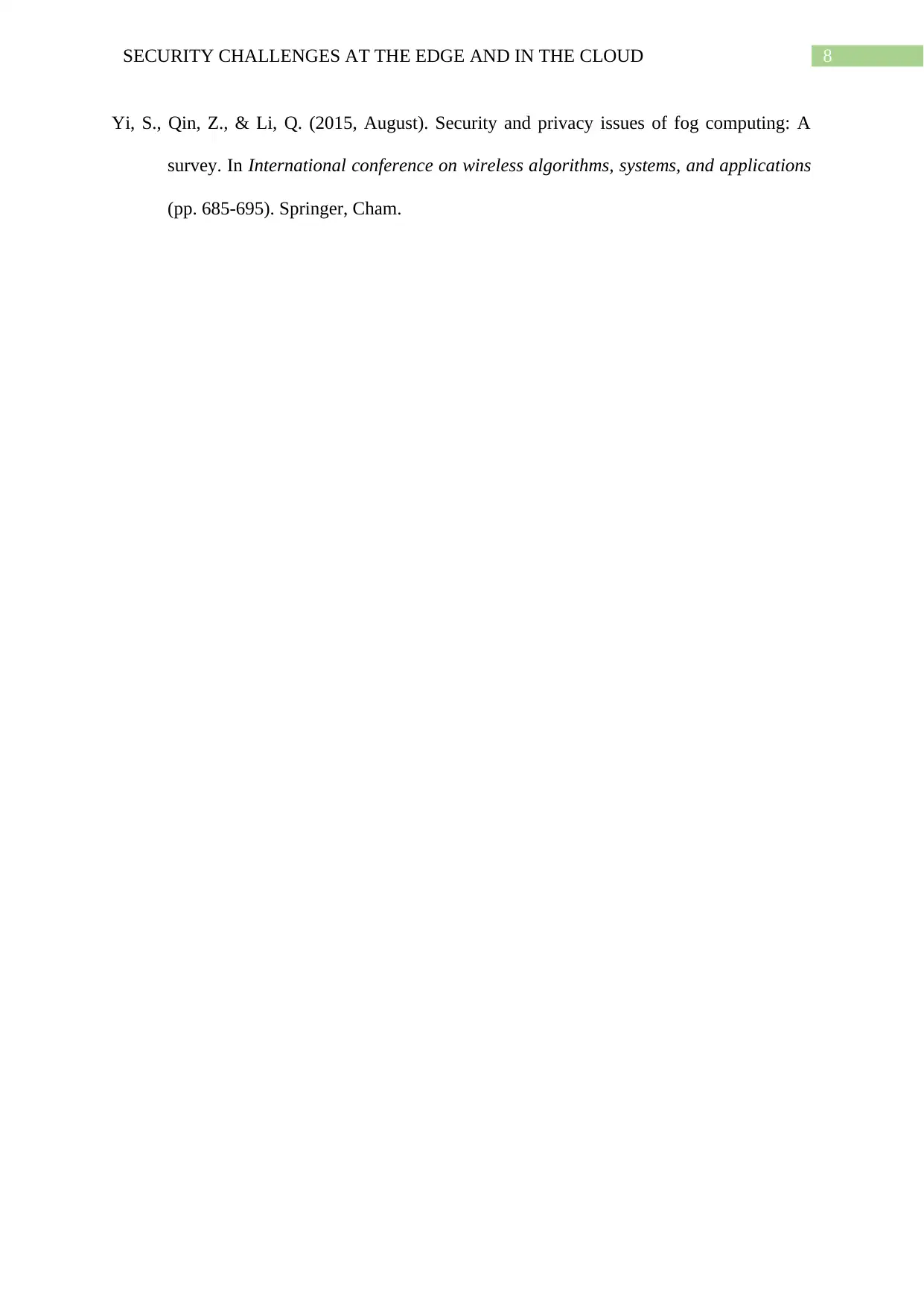
8SECURITY CHALLENGES AT THE EDGE AND IN THE CLOUD
Yi, S., Qin, Z., & Li, Q. (2015, August). Security and privacy issues of fog computing: A
survey. In International conference on wireless algorithms, systems, and applications
(pp. 685-695). Springer, Cham.
Yi, S., Qin, Z., & Li, Q. (2015, August). Security and privacy issues of fog computing: A
survey. In International conference on wireless algorithms, systems, and applications
(pp. 685-695). Springer, Cham.
⊘ This is a preview!⊘
Do you want full access?
Subscribe today to unlock all pages.

Trusted by 1+ million students worldwide
1 out of 9
Related Documents
Your All-in-One AI-Powered Toolkit for Academic Success.
+13062052269
info@desklib.com
Available 24*7 on WhatsApp / Email
![[object Object]](/_next/static/media/star-bottom.7253800d.svg)
Unlock your academic potential
Copyright © 2020–2025 A2Z Services. All Rights Reserved. Developed and managed by ZUCOL.





